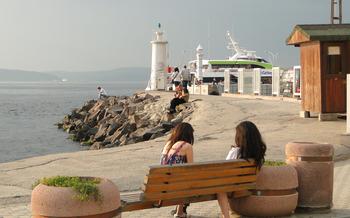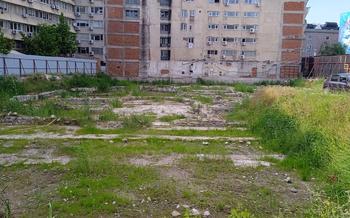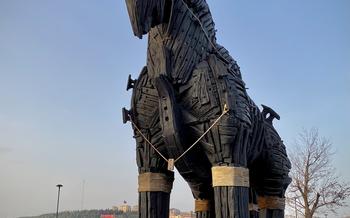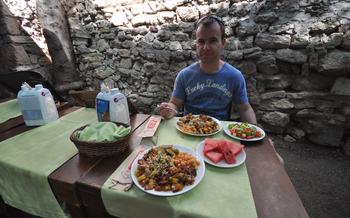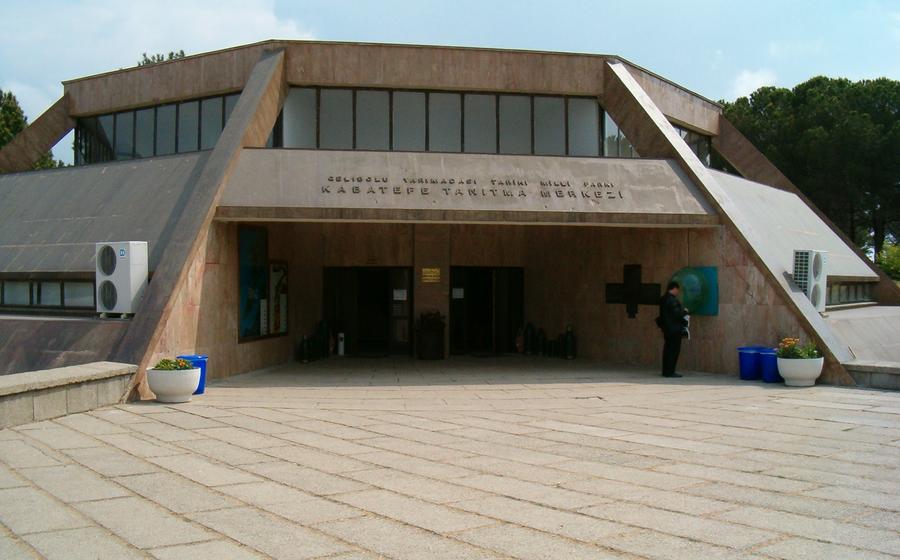
Kabatepe Museum
- Kabatepe Museum: A Journey Through Time
- Ancient City of Assos: The Setting
- Exploring the Museum's Collection
- The Temple of Athena: A Sacred Legacy
- The Necropolis: A Silent City
- The Agora: Center of Public Life
- The Theater: A Stage for Entertainment
- Architectural Design
- Seating Arrangements
- Acoustical Properties
- Performances and Events
- The Gymnasium: Nurturing Body and Mind
- The Odeon: A Smaller Theater
- The Bouleuterion: A Council Chamber
- The Byzantine Church: A Glimpse into the Past
- The Ottoman Fortress: A Strategic Stronghold
- Insider Tip: Off-the-Beaten-Path Discoveries
Kabatepe Museum: A Journey Through Time
The Kabatepe Museum is a testament to the rich history and cultural heritage of Assos, an ancient city located in the Çanakkale province of Turkey. Established in 1972, the museum houses a remarkable collection of artifacts unearthed during archaeological excavations conducted in Assos and its surrounding areas. It offers visitors a captivating journey through time, immersing them in the vibrant past of this once-thriving metropolis.
The museum's exhibits showcase a diverse array of archaeological treasures, including sculptures, pottery, coins, and inscriptions that shed light on the daily lives, religious practices, and artistic achievements of the ancient inhabitants of Assos. Through interactive displays and educational programs, the museum provides visitors with a deeper understanding of the city's history, its role in the region, and its enduring legacy that continues to inspire and captivate.
Ancient City of Assos: The Setting
Historical Background Nestled along the picturesque Turkish coast, the ancient city of Assos stands as a testament to the rich history and cultural heritage of the region. Founded in the 7th century BC by Aeolian colonists from Lesbos, Assos quickly rose to prominence as a thriving port city and a significant center of learning and philosophy. Throughout its history, it has been ruled by various civilizations, including the Lydians, Persians, Greeks, and Romans, each leaving their unique mark on its architectural landscape and cultural traditions.
Architectural Remains As you explore the ancient city, you will be greeted by an array of well-preserved ruins that speak to the grandeur and sophistication of Assos in its heyday. Among the most notable structures is the Temple of Athena, an iconic symbol of the city that stands atop a hill overlooking the Aegean Sea. The well-preserved theater, with its impressive acoustics, offers a glimpse into the city's vibrant cultural life, where plays, musical performances, and public gatherings were held.
Panoramic Views One of the highlights of visiting Assos is the breathtaking panoramic views that it offers. From the Temple of Athena, you can enjoy sweeping vistas of the azure waters of the Aegean Sea, the lush green valleys, and the distant islands. The city's strategic location on a hillside provides visitors with unparalleled opportunities to capture stunning photographs and create lasting memories of their visit.
Natural Beauty Assos is not only rich in history and culture but also blessed with an abundance of natural beauty. Surrounded by lush forests, olive groves, and crystal-clear waters, the city offers a serene escape into nature's embrace. Visitors can explore the scenic hiking trails that wind through the surrounding hills, offering panoramic views and opportunities to encounter local flora and fauna.
Exploring the Museum's Collection
The Kabatepe Museum houses a wealth of artifacts excavated from the ancient city of Assos, offering visitors a glimpse into the rich history and culture of this once-thriving metropolis. Sculptures, pottery, and coins unearthed from the ruins provide tangible evidence of the city's artistic and economic prowess. Inscriptions and stelae, etched with ancient Greek and Latin characters, offer insights into the lives and beliefs of the people who once called Assos home. Interactive displays, including touchscreens and multimedia presentations, bring the museum's collection to life, providing visitors with an immersive and engaging experience that makes history come alive.
The Temple of Athena: A Sacred Legacy
Architectural Significance The Temple of Athena, situated atop the acropolis of ancient Assos, stands as an architectural masterpiece. Constructed in the 6th century BC, the temple features a Doric style with six columns on its narrow ends and eleven columns on its long sides. The well-preserved ruins allow visitors to admire the temple's harmonious proportions and intricate details, showcasing the exceptional craftsmanship of ancient Greek builders.
History and Mythology Dedicated to the goddess Athena, the temple served as a religious center for the people of Assos. According to Greek mythology, Athena was the goddess of wisdom, war, and crafts, and her presence in Assos was believed to bring prosperity and protection to the city. Excavations at the site have revealed numerous artifacts and inscriptions that shed light on the temple's history and the religious practices associated with it.
Restoration Efforts In the 19th century, the temple underwent extensive restoration efforts led by French archaeologists. These efforts aimed to preserve the temple's structure and restore it to its former glory. The restoration work included the reconstruction of fallen columns, the repair of damaged architectural elements, and the removal of vegetation that had overgrown the site.
Ongoing Archaeological Research The Temple of Athena continues to be a subject of ongoing archaeological research. Excavations in the surrounding area have uncovered additional artifacts and inscriptions that provide valuable insights into the temple's history and the daily lives of the ancient inhabitants of Assos. Researchers are also studying the temple's architectural features and construction techniques to gain a deeper understanding of ancient Greek architecture.
The Necropolis: A Silent City
Epitaphs and inscriptions: Throughout the necropolis, visitors can find a variety of epitaphs and inscriptions carved onto the tombs and sarcophagi. These inscriptions offer valuable insights into the lives and deaths of the individuals buried here. They often include the names of the deceased, their family relationships, and their social status. Some inscriptions also include brief poems or prayers, expressing the grief and love of the bereaved. By studying these inscriptions, archaeologists and historians can learn more about the social and cultural practices of the ancient Assos community.
Historical insights: The necropolis provides a unique glimpse into the history of Assos and its people. By studying the tombs and their contents, archaeologists can learn about the city's development over time, its social stratification, and its religious beliefs and practices. The necropolis also offers insights into the daily lives of the ancient Assos inhabitants, their customs, and their relationships with each other. By carefully examining and interpreting the evidence found in the necropolis, researchers can piece together a more complete picture of life in this ancient city.
The Agora: Center of Public Life
The agora was the heart of ancient Assos, serving as a bustling marketplace and a vibrant civic center. This open area, which was located in the city's center, played a crucial role in the social and economic life of the community. The agora was a place where people from all walks of life converged to conduct business, exchange goods, and engage in lively discussions.
The architectural features of the agora are a testament to its significance. The square-shaped space was surrounded by a colonnade, which provided shelter from the sun and rain while creating a sense of order and grandeur. Within the agora, there were various shops and public buildings, including a market building, a council chamber, and a temple. These structures were typically constructed with local stone and featured intricate carvings and decorations that reflected the city's cultural heritage.
The agora was not merely a place of commerce but also a hub for social and political activities. It was here that citizens gathered to discuss important issues, make decisions, and celebrate religious festivals. The agora served as a venue for public assemblies, theatrical performances, and athletic competitions, fostering a sense of community and civic pride among the people of Assos.
The remains of shops and public buildings that can still be seen within the agora provide a glimpse into the vibrant atmosphere and bustling activities that once took place in this central space. Visitors can imagine the merchants displaying their wares, the farmers selling their produce, and the citizens engaging in lively debates as they strolled through the agora, the heart of ancient Assos.
The Theater: A Stage for Entertainment
Majestically situated on a hillside overlooking the Aegean Sea, the ancient theater of Assos is a testament to the city's rich cultural heritage and its significance as a center of performing arts in antiquity.
Architectural Design
Constructed in the 4th century BC, the theater boasts an impressive architectural design that showcases the engineering prowess of the ancient Greeks. Built into the natural slope of the hill, the theater comprises a large, semicircular auditorium with tiered seating arranged in concentric rows. The seating sections are divided by diazoma, or horizontal aisles, allowing for easy movement of spectators.
Seating Arrangements
The theater's seating capacity is estimated to be around 2,500, with the front rows reserved for dignitaries and officials. The seats are made of limestone blocks and are designed to provide excellent visibility and acoustics, ensuring that every spectator had an immersive and enjoyable experience.
Acoustical Properties
The theater's remarkable acoustics are attributed to its careful design and construction. The sloping rows of seats and the curved shape of the auditorium create a natural amphitheater effect, enhancing the clarity and projection of sound. This acoustic excellence allowed for performances to be heard and appreciated by all in attendance.
Performances and Events
The theater served as a venue for a variety of performances and events in ancient times. Dramatic plays, musical concerts, and poetry recitals were among the popular entertainments enjoyed by the citizens of Assos. The theater also hosted religious festivals and ceremonies, further cementing its significance as a central gathering place for the community.
The Gymnasium: Nurturing Body and Mind
The gymnasium, a prominent feature of ancient Greek education, played a crucial role in shaping the minds and bodies of Assos's youth. This complex, dedicated to physical training and intellectual pursuits, consisted of various facilities that catered to the holistic development of young citizens.
At the heart of the gymnasium lay a spacious courtyard, where students engaged in athletic activities such as wrestling, running, and jumping. Surrounding the courtyard were colonnaded walkways, providing shade and shelter during inclement weather. Along these walkways, students could engage in philosophical discussions with their teachers, exploring the works of great thinkers like Plato and Aristotle.
One of the most striking features of the gymnasium is its impressive collection of sculptures and mosaics. These artworks, depicting scenes of athletic competitions and mythological tales, served as both inspiration and decoration. The gymnasium's collection also includes a number of inscriptions, providing valuable insights into the daily life and values of ancient Assos.
In addition to its athletic and philosophical components, the gymnasium also served as a center for social interaction and community gatherings. Here, young men from different social backgrounds came together to learn, train, and form lasting bonds. The gymnasium was a place where the future leaders of Assos were shaped, both physically and intellectually.
The Odeon: A Smaller Theater
The Odeon, a smaller theater, stands as a testament to the cultural significance of Assos. With a capacity of approximately 600 seats, it was designed for more intimate performances and events. The Odeon's architectural features mirror those of the larger theater, with a semi-circular orchestra and tiered seating. Its smaller size creates a more intimate atmosphere, allowing audiences to connect with the performers on a deeper level.
The Odeon served as a venue for music and poetry recitals, as well as other cultural events. Its acoustics were carefully engineered to ensure optimal sound quality, making it an ideal space for musical performances and spoken word events. The Odeon's rich history and intimate setting make it a unique and captivating experience for visitors.
The Bouleuterion: A Council Chamber
The Bouleuterion, or council chamber, was a crucial venue for political decision-making in ancient Assos. It served as the meeting place for the city's governing body, known as the Boule, or council. Constructed in the 4th century BC, this impressive structure bears testament to the city's democratic traditions and the importance of civic engagement.
The Bouleuterion's architecture reflects its significant role in Assos's governance. Built in a semi-circular shape, the chamber features tiers of stone benches arranged in a theater-style seating plan. This design facilitated lively debates and discussions among council members as they addressed matters of law, administration, and public policy.
The Bouleuterion's location within the city's political and administrative center further highlights its importance. Situated near the agora and the theater, it formed part of a complex of civic buildings where the city's leaders conducted their duties and made decisions that shaped the lives of Assos's citizens.
Although the Bouleuterion has undergone significant changes over the centuries, its imposing ruins offer a glimpse into the vibrant political life of ancient Assos. Through careful restoration efforts, visitors can experience the atmosphere of this once-bustling chamber and gain insights into the democratic processes that governed this ancient city-state.
The Byzantine Church: A Glimpse into the Past
Nestled amidst the ruins of ancient Assos, the Byzantine Church stands as a testament to the region's rich religious history. Constructed during the Byzantine Empire, which ruled the region from the 4th to the 15th century AD, the church represents a significant chapter in Assos' story.
Its architectural style reflects the Byzantine influence, with a central dome supported by four pillars, creating a spacious and airy interior. The church's walls once adorned with frescoes and mosaics, depicting biblical scenes and religious figures, have faded with time, yet still offer a glimpse into the artistic traditions of the Byzantine era.
Although its exact purpose remains uncertain, the church likely served as a place of worship and assembly for the Christian community of Assos. It stood as a symbol of religious devotion and played a vital role in the spiritual lives of its inhabitants.
The presence of the Byzantine Church serves as a reminder of the diverse cultural and religious influences that have shaped Assos throughout its history. It invites visitors to contemplate the rich tapestry of beliefs and traditions that have left their mark on this ancient city.
The Ottoman Fortress: A Strategic Stronghold
The Ottoman Fortress stands as a testament to the strategic importance of Kabatepe throughout history. Built in the 15th century, this formidable structure played a crucial role in defending the region against potential invaders. Its imposing walls, towers, and bastions speak to the engineering prowess of the Ottoman Empire.
The fortress's strategic location, perched atop a hill overlooking the Aegean Sea, allowed the Ottomans to control access to the Dardanelles Strait, a vital waterway connecting the Aegean and Black Seas. This strategic position made the fortress a key defensive point during the Ottoman-Venetian wars.
The fortress's architectural features reflect its military purpose. Its thick walls, reinforced with towers and bastions, provided a strong defense against enemy attacks. The fortress also featured a series of gates and drawbridges, which could be used to control access and prevent unauthorized entry.
Today, the Ottoman Fortress stands as a symbol of Kabatepe's rich history. Although it is no longer in use as a military stronghold, it remains an impressive sight that attracts visitors from around the world. The fortress offers stunning panoramic views of the surrounding countryside and the Aegean Sea, making it a popular spot for photography and sightseeing.
Insider Tip: Off-the-Beaten-Path Discoveries
While in Çanakkale, venture beyond the Kabatepe Museum and explore the town of Assos itself. Stroll through its charming streets, lined with traditional Ottoman and Greek houses, and soak in the unique atmosphere of this ancient city. Discover hidden gems like the picturesque harbor, where you can enjoy fresh seafood at local restaurants. For a secluded beach experience, head to Sivrice Beach, a secluded stretch of sand and crystal-clear waters just a short drive away. Indulge in local delicacies such as freshly caught fish, olive oil, and homemade jams, reflecting the rich culinary heritage of the region. Embark on a culinary journey by visiting local markets and sampling the flavors of Assos.
